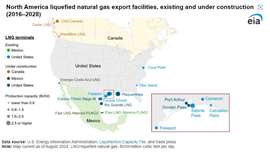Read this article in 中文 Français Deutsch Italiano Português Español
Mexico’s first LNG export facility ships first cargo
August 16, 2024
New Fortress Energy producing LNG on FLNG vessel
The first liquefied natural gas (LNG) export facility in Mexico has shipped its first cargo, with the LNG sailing via the Panama Canal to Mexico’s LNG import terminal in Baja California Sur, the U.S. Energy Information Administration (EIA) reports.

Developer New Fortress Energy produced the LNG aboard an offshore Floating LNG (FLNG) production vessel with a capacity to liquefy up to 0.199 billion cubic feet per day (Bcf/d) of natural gas—one of two FLNG production units that are part of the Fast LNG Altamira export project on the east coast of Mexico. U.S. natural gas delivered via the Sur de Texas-Tuxpan pipeline supplies the project.
The FLNG production vessel has a modular design and is accompanied by a Floating Storage Vessel (Floating Storage Unit, or FSU) to store LNG until it is transferred to an LNG vessel carrier for delivery to import destinations.
LNG exports from this project are subject to regulatory approvals by the U.S. Department of Energy (DOE) because it is fed by natural gas sourced from the United States. DOE has authorized 0.43 Bcf/d of LNG exports from Fast LNG Altamira to countries with which the United States has a Free Trade Agreement (FTA). Fast LNG Altamira also requested export authorization for 0.4 Bcf/d of exports to non-FTA countries, which is currently pending. FTA countries combined imported 7.4 Bcf/d of global LNG supply in 2023, accounting for 14% of the global LNG imports, according to data by the International Group of Liquefied Natural Gas Importers (GIIGNL). The LNG import (regasification) capacity of FTA countries is approximately 27.3 Bcf/d.
Mexico’s Energia Costa Azul LNG terminal on the west coast is also currently under construction; it has an export capacity of 0.4 Bcf/d for Phase 1 and an additional 1.6 Bcf/d for Phase 2 (proposed). Developers proposed other LNG export projects for Mexico’s west coast, including Saguaro Energia LNG (2.0 Bcf/d capacity), Amigo LNG (1.0 Bcf/d capacity), Gato Negro LNG (0.6 Bcf/d capacity), Salina Cruz LNG (0.4 Bcf/d capacity), and Vista Pacifico LNG (0.5 Bcf/d capacity), with a combined export capacity of nearly 4.5 Bcf/d.
MAGAZINE
NEWSLETTER

CONNECT WITH THE TEAM









